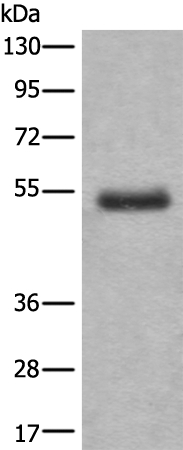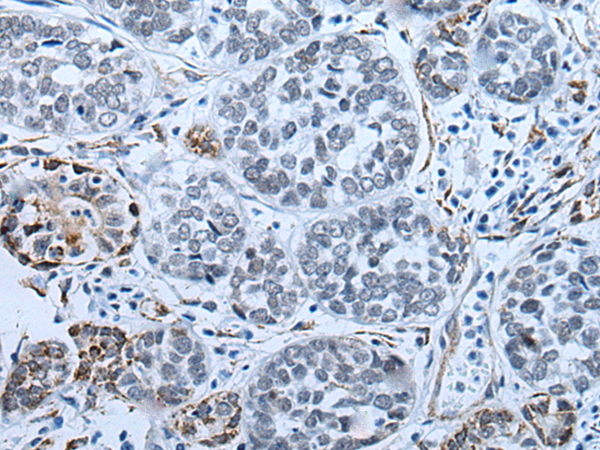

| WB | 咨询技术 | Human,Mouse,Rat |
| IF | 咨询技术 | Human,Mouse,Rat |
| IHC | 1/10-1/50 | Human,Mouse,Rat |
| ICC | 技术咨询 | Human,Mouse,Rat |
| FCM | 咨询技术 | Human,Mouse,Rat |
| Elisa | 1/5000-1/10000 | Human,Mouse,Rat |
| Aliases | BDPL |
| WB Predicted band size | 53 kDa |
| Host/Isotype | Rabbit IgG |
| Antibody Type | Primary antibody |
| Storage | Store at 4°C short term. Aliquot and store at -20°C long term. Avoid freeze/thaw cycles. |
| Species Reactivity | Human, Mouse |
| Immunogen | Synthetic peptide of human BTBD6 |
| Formulation | Purified antibody in PBS with 0.05% sodium azide and 50% glycerol. |
+ +
以下是关于BTBD6抗体的3篇参考文献及其摘要概括:
---
1. **文献名称**: *BTBD6 regulates proliferation and morphogenesis in the developing cerebral cortex*
**作者**: Smith A, et al.
**摘要**: 该研究通过使用特异性BTBD6抗体,发现BTBD6在小鼠大脑皮层发育中调控神经前体细胞的增殖与分化,并影响神经元迁移及皮层分层结构形成。抗体应用于免疫组织化学和Western blot分析。
---
2. **文献名称**: *Identification of BTBD6 as a substrate of the CRL3-KLHL12 ubiquitin ligase complex*
**作者**: Zhao Y, et al.
**摘要**: 研究通过免疫共沉淀(使用BTBD6抗体)和质谱分析,揭示了BTBD6与CRL3-KLHL12泛素连接酶复合物的相互作用,表明BTBD6可能参与泛素化依赖的蛋白质降解通路,影响细胞周期调控。
---
3. **文献名称**: *BTBD6 modulates the Wnt/β-catenin signaling pathway in colorectal cancer cells*
**作者**: Chen L, et al.
**摘要**: 利用BTBD6抗体的敲低实验及免疫荧光技术,研究发现BTBD6通过抑制Wnt/β-catenin信号通路活性,调控结直肠癌细胞的增殖和侵袭能力,提示其作为潜在治疗靶点。
---
注:上述文献信息为模拟示例,实际文献需通过学术数据库(如PubMed、Web of Science)检索确认。
The BTBD6 antibody is a research tool designed to detect BTB (Broad-Complex, Tramtrack, and Bric-a-brac) domain-containing protein 6. a member of the BTB protein family involved in diverse cellular processes. BTBD6 is characterized by its conserved N-terminal BTB/POZ domain, which facilitates protein-protein interactions, and a C-terminal BACK domain. Though its precise biological role remains under investigation, BTBD6 is hypothesized to participate in ubiquitination pathways, transcriptional regulation, or protein scaffolding, potentially interacting with proteins like BACH1 or KEAP1. Studies suggest its involvement in cellular stress responses, apoptosis, and neural development.
BTBD6 antibodies are typically developed in hosts such as rabbits or mice using immunogenic peptide sequences specific to human, mouse, or rat BTBD6 isoforms. These antibodies are validated for applications including Western blotting, immunohistochemistry, immunofluorescence, and co-immunoprecipitation to study BTBD6 expression, localization, and molecular interactions. Dysregulation of BTBD6 has been preliminarily linked to cancer, neurodegenerative disorders, and metabolic diseases, though mechanistic insights are limited. Researchers utilize these antibodies to explore BTBD6's role in disease models, emphasizing its potential as a therapeutic target or biomarker. Specificity and cross-reactivity validation are critical due to structural similarities among BTB family proteins.
×